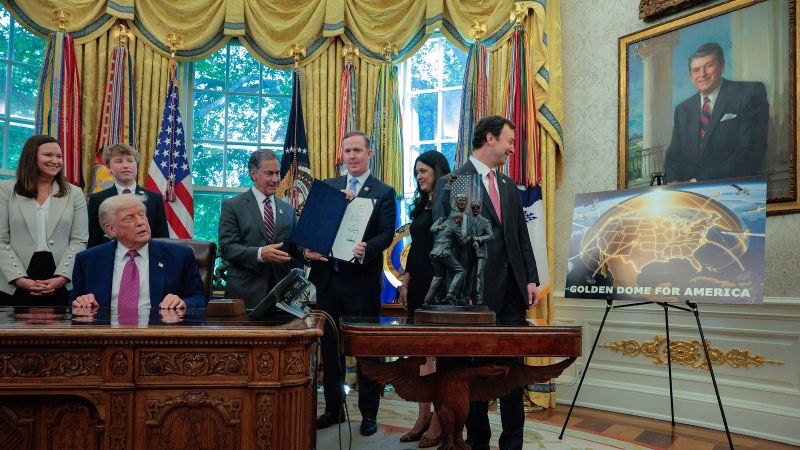The Pentagon has made significant strides toward realizing President Donald Trump’s ambitious vision for a sophisticated defense system dubbed “Golden Dome.” This prospective missile shield aims to protect the United States from potential long-range attacks and is projected to incur costs amounting to hundreds of billions of dollars. Reports indicate that the Pentagon has submitted a range of options—small, medium, and large—to the White House, which are now under consideration.
In the coming days, President Trump is expected to reveal which option he favors, along with its corresponding price tag. This decision is crucial as it will dictate the funding strategy, developmental timeline, and ultimate implementation of the Golden Dome defense system over the next several years. The project represents an enormous financial burden, initially allocated $25 billion in next year’s defense budget, although projections from the Congressional Budget Office suggest that the total expenditure could exceed $500 billion spread over two decades.
The monumental undertaking is likely to create lucrative opportunities for private defense contractors. The scale of the Golden Dome initiative means that it cannot be solely produced by government entities; thus, private companies are invited to participate. Notably, SpaceX, founded by Elon Musk, is among the frontrunners to secure contracts related to the Golden Dome system, underscoring the collaboration between governmental agencies and cutting-edge private entities.
Chief Pentagon spokesman Sean Parnell has articulated that the Department of Defense has already crafted a preliminary architecture for the Golden Dome project. He emphasizes that this system aims to safeguard American citizens and the homeland from a spectrum of global missile threats. According to Parnell, the Secretary of Defense and key department leaders have engaged with President Trump to present viable options and anticipate a forthcoming announcement regarding how to proceed.
A pivotal component of the development plan involves establishing a dedicated program manager—informally dubbed the “golden dome czar”—to oversee the intricate development and operational phases of the defense system. General Michael A. Guetlein, who currently serves as the vice chief of space operations at the U.S. Space Force, is reportedly being considered for this role due to his extensive experience in missile defense systems and emerging capabilities in space.
However, many uncertainties still loom over Golden Dome. There is speculation that the full system will comprise about 100 interrelated programs, spanning existing and developing initiatives within the Defense Department, with a significant component expected to be the command and control and integration layer of the architecture.
The quest for an all-encompassing missile defense system is not new to U.S. policy; it has been pursued for decades but has remained unachievable due to technological gaps and cost concerns. Trump has drawn parallels between Golden Dome and Israel’s Iron Dome, insisting the U.S. must adopt a corresponding missile defense program. However, defense analysts stress that such comparisons are misleading, as the two systems differ greatly in both scale and function. The Iron Dome primarily addresses short-range threats within Israel’s borders, whereas the Golden Dome aims for a comprehensive defense against long-range missile threats.
An unclassified assessment published by the Defense Intelligence Agency titled “Golden Dome for America” highlights the grave risks posed by adversarial nations, including China, Russia, Iran, and North Korea, which possess the capacity to target the U.S. with a variety of missile technologies.
The fundamental decision at the heart of Trump’s strategy revolves around developing next-generation capabilities to protect the U.S. from intercontinental ballistic missiles (ICBMs) and hypersonic threats. This innovative approach necessitates extensive research and development and a cohesive network of governmental and private sector collaboration, the intricacies of which are yet to be fully understood.
SpaceX is notably pursuing an integral role in creating Golden Dome, having already engaged with Trump officials regarding potential collaborative efforts. This also includes partnerships with two other technology firms, Anduril and Palantir, to bolster the capabilities needed for such an advanced defense system. Such high-profile involvement from notable defense contractors showcases the competitive nature of the bidding process that is anticipated to unfold, facilitated through the Defense Innovation Unit.
These developments come amid scrutiny of Musk’s close ties to Trump and consequent calls from Democratic lawmakers for investigations into the implications of these relationships on the awarding of contracts for Golden Dome. While concerns have been raised, some defense experts have asserted SpaceX’s competence, emphasizing that their existing capabilities in sensor technology make them a front-runner for contract opportunities.
As discussions regarding budget allocations continue, it has been reported that lawmakers have earmarked a “down payment” for Golden Dome, focusing on essential components like satellites and space-based sensors in the upcoming defense budget, totaling $25 billion. However, this funding only represents a fraction of the projected costs associated with the comprehensive development and maintenance of the system.
In conclusion, the road ahead for the Golden Dome initiative appears fraught with challenges and complexities. With a slew of internal deadlines and bureaucratic obstacles already causing delays, the efficient execution of this ambitious project is paramount. As the administration seeks to validate the feasibility of the concept, the clock is ticking



